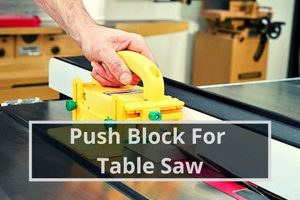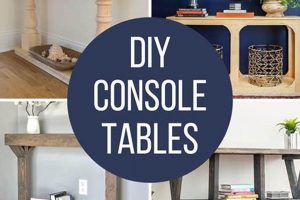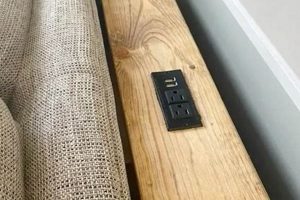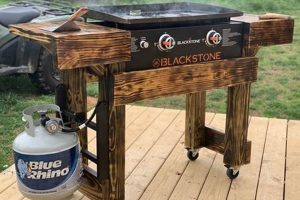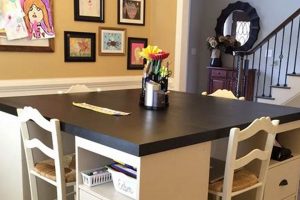A constructed surface designed for Lego brick play, often utilizing components from a Swedish furniture retailer, exemplifies a common approach to creating dedicated spaces for constructive activity. These builds typically involve adapting an existing table frame from the aforementioned retailer and integrating a surface compatible with Lego baseplates. Examples range from simple alterations to more elaborate designs incorporating storage and organization features.
Creating such a dedicated play area fosters creativity and provides a designated space, thus encouraging organization. Historically, repurposing existing furniture for specialized activities has been a practical method of optimizing available space and reducing expenses. This approach aligns with broader trends toward customizable and adaptable home environments, reflecting a preference for solutions tailored to specific needs and spatial constraints.
The subsequent sections will explore various techniques for assembling such tables, examine the specific materials involved, and provide guidance on customizing the design to accommodate different needs and preferences. These topics will delve into the practical considerations and creative possibilities associated with constructing a personalized play environment.
Construction Guidance
The following guidance offers practical advice for building a dedicated Lego brick play surface, often incorporating furniture elements from a Swedish retailer. Adherence to these suggestions can optimize the resulting construction’s functionality and durability.
Tip 1: Surface Selection: Prioritize a durable surface material suitable for repeated use and cleaning. Medium-density fiberboard (MDF) offers a balance of cost-effectiveness and workability, while plywood provides increased structural integrity. Ensure the chosen material is appropriately sealed to prevent moisture damage.
Tip 2: Baseplate Adhesion: Secure Lego-compatible baseplates to the surface using a suitable adhesive. Consider using a construction adhesive or double-sided adhesive tape designed for permanent bonding. Proper adhesion prevents shifting and detachment during play.
Tip 3: Frame Reinforcement: Reinforce the table frame, particularly if utilizing a pre-existing structure from the aforementioned retailer. Additional bracing or corner supports can enhance stability and prevent wobbling, especially when subjected to the weight of Lego bricks and children’s play.
Tip 4: Edge Treatment: Implement edge banding or trim to protect the edges of the surface material. This measure enhances the aesthetic appeal and prevents chipping or splintering, thereby increasing safety and longevity.
Tip 5: Storage Integration: Incorporate storage solutions directly into the design. Drawers, shelves, or under-table bins provide convenient organization for Lego bricks and accessories, promoting tidiness and accessibility.
Tip 6: Height Consideration: Determine an appropriate table height based on the age and typical posture of the user. A height that promotes comfortable access and minimizes strain during play is crucial for prolonged engagement.
Tip 7: Workspace Illumination: Ensure adequate lighting to facilitate detailed brick assembly and minimize eye strain. Consider integrating a task light or positioning the table in a well-lit area.
These construction practices aim to enhance the play surface’s functionality, safety, and longevity. Employing these methods contributes to a more conducive environment for constructive activities.
The subsequent section will address design customizations and further enhancements that can be implemented to tailor the play area to individual needs and preferences.
1. Adaptable Dimensions
The concept of adaptable dimensions is fundamentally important when repurposing mass-produced furniture, particularly those from a Swedish retailer, into a dedicated Lego play surface. The ability to modify standard sizes to suit specific spatial constraints or user needs greatly enhances the utility and integration of the final product.
- Spatial Optimization
Adaptable dimensions permit the creation of play surfaces tailored to available room space. A small apartment might necessitate a compact, square surface, while a larger playroom could accommodate a sprawling, rectangular arrangement. Failure to consider spatial limitations can result in a cumbersome and impractical addition to the home.
- User Height Accommodation
Adjusting the height of the surface to suit the user’s age and stature is crucial for ergonomic comfort. A surface that is too low can cause slouching and back strain, while one that is too high can restrict access and maneuverability. Adaptable dimensions enable customization to promote proper posture and prolonged engagement.
- Modular Expansion
The ability to add or remove sections allows the play surface to grow with the user’s collection or changing needs. A modular design enables the incorporation of additional storage, workspace, or play areas as required. This adaptability extends the lifespan and utility of the initial investment.
- Accessibility Considerations
Adaptable dimensions facilitate the creation of play surfaces that accommodate users with mobility challenges. A lower table height, combined with ample knee space, can enhance accessibility for individuals using wheelchairs or other assistive devices. This inclusive design promotes equal access to play and creative activities.
In summary, adaptable dimensions are central to the successful integration of modified furniture into a functional and personalized Lego play area. Addressing spatial limitations, user height, modular expansion, and accessibility considerations through dimensional adjustments ensures a tailored and user-friendly environment for creative construction.
2. Surface Compatibility
Surface compatibility is a pivotal element in the successful implementation of a modified Lego play surface utilizing furniture components from a Swedish retailer. The direct relationship between surface characteristics and brick connectivity dictates the functionality and usability of the resulting construction. An incompatible surface renders the entire project ineffective, as Lego bricks cannot be securely attached for building and display purposes. A real-world illustration of this is a table surfaced with smooth laminate; Lego baseplates or bricks will not adhere without modification, defeating the purpose of a dedicated construction area. Conversely, integrating authentic Lego baseplates or surfaces designed with comparable stud dimensions enables a seamless and functional play experience. Proper surface selection is therefore a foundational requirement.
The practical significance of understanding surface compatibility extends beyond simple attachment. The type of material influences both the longevity of the structure and the play experience. For instance, a warped or uneven surface will compromise the structural integrity of Lego models, leading to instability and potential collapse. Furthermore, the chosen adhesive used to affix baseplates, or the material comprising the surface itself, needs to be non-toxic and durable to withstand frequent use. Surfaces that are easily scratched or damaged may detract from the overall aesthetic and necessitate frequent repairs, increasing the long-term cost and maintenance requirements. Materials like Medium-Density Fiberboard (MDF) require sealing to protect against moisture damage that can delaminate the surface.
In summary, ensuring surface compatibility is not merely a matter of aesthetic or incidental concern; it is a fundamental design criterion that directly determines the usability, durability, and overall success of a Lego construction surface utilizing repurposed furniture. Understanding and addressing the material characteristics, attachment methods, and user needs is essential for creating a functional and engaging play environment. Neglecting this consideration undermines the entire project, rendering it aesthetically displeasing and functionally inept.
3. Structural Integrity
Structural integrity constitutes a crucial element in the design and construction of any modified Lego brick play surface utilizing furniture components, especially those sourced from mass-market retailers. The surface’s capacity to withstand applied loads and resist deformation directly impacts its safety, longevity, and usability. A lack of adequate structural reinforcement can lead to instability, failure, and potential injury, rendering the surface unsuitable for its intended purpose.
- Frame Reinforcement
The underlying frame, often derived from an existing table structure, requires thorough assessment and potential reinforcement. Mass-produced furniture is not always designed to support the concentrated weight of Lego bricks, particularly in substantial quantities, or the dynamic loads imposed during active play. Adding bracing, corner supports, or strengthening the existing joints enhances the frame’s capacity to bear weight and resist deformation. Failure to address frame integrity can result in wobbling, sagging, or even collapse.
- Surface Material Selection
The chosen surface material, whether medium-density fiberboard (MDF), plywood, or solid wood, must possess sufficient rigidity and load-bearing capacity. Thin or flexible materials will bow under the weight of Lego bricks, creating an uneven and unstable play surface. Selecting a thicker gauge material or adding a supporting substructure beneath the surface enhances its resistance to deflection and ensures a level and consistent plane for building.
- Joint Construction
The manner in which the surface material is joined to the frame is critical for maintaining structural stability. Screws, bolts, or adhesives should be appropriately sized and applied to create a secure and durable connection. Weak or poorly executed joints can lead to separation, weakening the overall structure and compromising its ability to withstand stress. Reinforcing joints with metal brackets or wood blocks provides added strength and prevents premature failure.
- Load Distribution
The placement of weight on the surface should be considered to minimize stress concentrations. Distributing the weight evenly across the surface, rather than concentrating it in a single area, reduces the risk of localized deformation or failure. Strategically positioning storage containers or reinforcing specific areas prone to higher loads can further enhance structural integrity. Consideration of dynamic loads, such as those generated by leaning or pressing on the surface, is also essential.
These considerations regarding structural integrity underscore the importance of careful planning and execution when constructing a modified Lego play surface. Addressing these factors ensures a safe, durable, and functional environment for creative construction, maximizing the value and longevity of the final product. Neglecting these elements can result in a compromised structure prone to failure, negating the benefits of a dedicated play area.
4. Storage Solutions
The integration of storage solutions represents a critical aspect of designing and constructing a modified Lego brick play surface utilizing furniture components. Efficient storage directly influences the usability, organization, and overall aesthetic of the play environment. Without dedicated storage, Lego bricks accumulate, creating clutter and hindering the creative process.
- Integrated Drawer Systems
Incorporating drawers directly beneath the play surface provides readily accessible storage for frequently used Lego bricks and components. These drawers can be custom-built to fit specific dimensions or repurposed from existing drawer units. A practical application involves integrating shallow drawers to organize bricks by color or type, facilitating efficient retrieval during construction. Failure to incorporate such systems results in disorganized piles of bricks and a less efficient play experience.
- Under-Table Bins and Shelves
Utilizing the space beneath the table for bins or shelves offers additional storage capacity for larger Lego sets, baseplates, or instruction manuals. Clear plastic bins allow for easy identification of contents, while shelves provide a dedicated space for displaying completed Lego models. For instance, a series of open shelves can house modular storage containers, each labeled with the type of Lego components they contain. The absence of such systems leads to the displacement of Lego bricks throughout the play area and surrounding environment.
- Side-Mounted Containers
Attaching containers to the sides of the table provides convenient storage for small, frequently used components, such as axles, connectors, and specialty pieces. These containers can be constructed from plastic, metal, or wood and mounted directly to the table frame. A specific example includes the use of repurposed spice racks or utensil holders to create accessible storage for small parts. The lack of such accessible storage often results in the loss of small components or their accumulation in hard-to-reach areas.
- Mobile Storage Carts
Employing mobile storage carts allows for flexible storage solutions that can be easily moved around the play area or transported to other locations. These carts can be equipped with drawers, shelves, or bins and used to store a variety of Lego bricks and accessories. An example implementation includes a rolling cart with divided compartments for sorting Lego bricks by size and color. The absence of mobile storage options limits the flexibility and adaptability of the play environment.
These facets of storage solutions illustrate the significant impact of thoughtful design on the usability and organization of a modified Lego brick play surface. Integrating dedicated storage systems enhances the play experience, promotes tidiness, and extends the lifespan of Lego bricks by protecting them from damage and loss. Neglecting these considerations results in a less efficient and less enjoyable play environment.
5. Ergonomic Design
Ergonomic design, when applied to the construction of a Lego play surface utilizing furniture components, addresses the interaction between the user and the work environment, aiming to optimize well-being and performance. The absence of ergonomic considerations in a modified Lego surface can lead to physical discomfort, reduced engagement, and potential long-term health issues. Cause and effect are directly linked: improper height or inadequate workspace will inevitably result in poor posture, straining of the neck, back, and wrists, especially during extended periods of Lego brick assembly. Consequently, ergonomic principles are not merely ancillary; they are a core component dictating the overall practicality and health benefits of the final product. Real-life examples of this include children developing chronic back pain or carpal tunnel syndrome due to poorly designed workspaces.
Practical application of ergonomic principles involves several key elements. The primary consideration is the table height. A surface too low forces the user to hunch over, while a surface too high causes shoulder strain. The ideal height should allow the user to maintain a neutral posture, with elbows at a 90-degree angle. Secondly, adequate legroom is crucial, allowing the user to sit comfortably and avoid cramping. Thirdly, the surface area should be sufficient to accommodate Lego bricks, baseplates, and instruction manuals without creating a cluttered and disorganized workspace. The incorporation of adjustable height mechanisms or tilting surfaces further enhances ergonomic benefits, adapting to various user preferences and tasks. For example, a tilting surface can reduce neck strain when working on intricate Lego models.
In conclusion, the integration of ergonomic design into a Lego surface construction significantly impacts its long-term utility and health benefits. Neglecting these principles results in a compromised play environment that can lead to physical discomfort and potential health problems. Addressing the table height, legroom, surface area, and adjustability factors ensures a comfortable, efficient, and sustainable environment for creative construction. While implementing ergonomic designs may present challenges such as increased construction costs or complexity, the long-term benefits outweigh these initial obstacles, ensuring a positive and healthy play experience. This understanding extends to the broader theme of creating safe and functional spaces for children’s activities, emphasizing the importance of prioritizing their physical well-being.
Frequently Asked Questions
The following addresses common inquiries regarding the construction and customization of Lego brick play surfaces utilizing furniture from a specific Swedish retailer. The aim is to provide clarity on practical considerations and design choices.
Question 1: What is the minimum recommended table size for a functional Lego play area?
The minimum recommended table size is dependent on the users age and Lego collection size. A surface area of at least 30 inches by 30 inches is advisable for younger users with smaller collections. Larger or older users with extensive collections may require a surface area of 48 inches by 48 inches or greater to accommodate building and storage needs adequately.
Question 2: What type of adhesive is best suited for attaching Lego-compatible baseplates to a table surface?
Construction adhesive designed for bonding dissimilar materials is generally recommended. This type of adhesive provides a strong, permanent bond between the baseplate and the table surface. Double-sided adhesive tape designed for permanent bonding can also be utilized, although its long-term durability may be less than that of construction adhesive.
Question 3: How can the structural integrity of a repurposed furniture frame be assessed prior to modification?
A visual inspection of the frame for signs of damage, such as cracks, splits, or loose joints, is essential. Applying moderate pressure to various points on the frame reveals potential weaknesses or instabilities. Reinforcement measures, such as adding bracing or corner supports, are advised if structural deficiencies are identified.
Question 4: What are the considerations for ensuring a safe and non-toxic play environment?
Selecting non-toxic materials for the surface and any applied finishes is paramount. Water-based paints and sealants are generally preferable to solvent-based alternatives. Ensuring adequate ventilation during construction and allowing sufficient drying time for finishes minimizes exposure to harmful chemicals.
Question 5: How can the table be customized to accommodate different types of Lego bricks, such as Duplo or Technic?
Implementing modular storage solutions, such as removable bins or trays, allows for segregation of different types of Lego bricks. Utilizing surfaces with varying stud sizes accommodates both Duplo and standard Lego bricks. Incorporating specialized components, such as Technic gear racks or axle holders, facilitates construction with Technic elements.
Question 6: What steps are necessary to ensure the long-term durability and maintainability of the constructed play surface?
Protecting the surface with a durable sealant or finish is essential for preventing scratches, stains, and moisture damage. Regular cleaning with a mild detergent and water removes dirt and debris. Periodically inspecting the frame and joints for signs of wear or damage and making necessary repairs extends the lifespan of the surface.
This FAQ section provides a foundation for understanding the practical aspects of Lego play surface construction. By considering these inquiries and their responses, constructors can navigate the project with greater confidence and achieve a satisfactory outcome.
The next section delves into specific material recommendations and their comparative advantages for building a robust and aesthetically pleasing Lego play environment.
Conclusion
This exploration of diy lego table ikea construction has highlighted critical factors influencing the functionality, durability, and ergonomic qualities of such surfaces. Surface compatibility, structural integrity, storage integration, and adaptable dimensions represent key determinants of a successful project. Careful consideration of these elements, informed by practical guidance and responses to frequently asked questions, enables a user to create a dedicated play area tailored to specific needs.
The potential for customizable play surfaces extends beyond mere recreation, offering opportunities for cognitive development and spatial reasoning in a structured environment. Future endeavors should focus on material innovation and design refinements that maximize accessibility and promote sustainable practices within the realm of diy lego table ikea endeavors. The ultimate outcome remains the fostering of creativity through enhanced physical resources.


